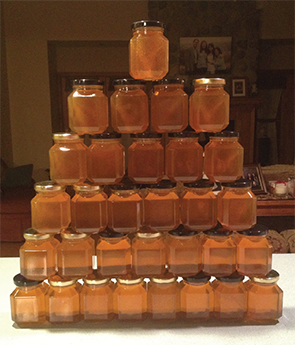He was hooked. The following spring, he purchased a bee suit, some basic tools and a Langstroth beehive, which is named after the father of American beekeeping—Reverend Lorenzo Lorraine Langstroth. The hive is made up of stacked boxes containing eight wooden frames in which bees build their comb, lay their eggs and make honey. He says his initial investment was less than $600.
Unlike a queen bee, which can live three to five years, worker bees live only about 40 days. The queen lays 2,000 eggs a day—or about 1 million during her lifetime. Worker bees perform specific duties at various ages. Young bees clean up the hive, for example, while older bees take care of the queen bee, search for pollen or serve as guard bees, he explains.
Unfortunately, bees can’t survive harsh winters. But temperatures during the past two years were warmer than usual and his bees thrived, making lots of honey. This past year, he and Christina, his 23-year-old daughter who shares his love of beekeeping, bottled 88 jars of honey as gifts for family and friends.
“When we give away the honey, people just go crazy,” he says, explaining that many different wildflowers like clover and goldenrod grow on 65 acres surrounding his home, which is in the Finger Lakes region in upstate New York, a big honeybee area for apiaries. “We really have delicious honey. It’s got a really distinct taste.”
Overlapping Skills

Last year, Dr. Ritchlin and his daughter bottled 88 jars of honey for family and friends.
Dr. Ritchlin’s home sits on five acres and houses a large vegetable garden in the backyard that consists of lettuce, peppers, tomatoes and other crops. He says the pollination from his honeybees has been “quite dramatic” in terms of their healthy size and quality.
He believes beekeeping is an ideal hobby for physicians because it’s not intensely time consuming and really helps the environment.
“All doctors have a scientific background so they understand the scientific and ecological elements of this, which is really important, says Dr. Ritchlin. “It’s critical that we bring back the pollinators and also become politically involved in limiting the toxins in the environment that are killing the pollinators.”
He explains that pesticides and fertilizers are deadly for bees and among the major reasons for the decimation of their population.
“We really need pollinators for the majority of our crops,” Dr. Ritchlin says. “This is a real problem. We need to come to grips with it.”
